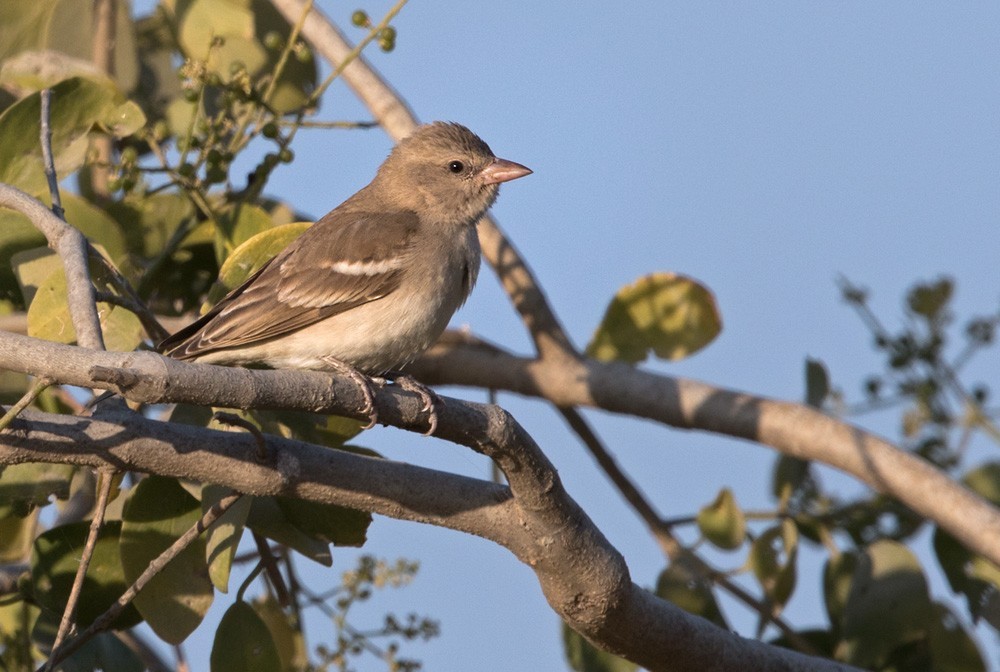Yellow-throated Sparrow
A species of Bush Sparrows, Also known as Chestnut-shouldered Rock Sparrow Scientific name : Gymnoris xanthocollis Genus : Bush Sparrows
Yellow-throated Sparrow, A species of Bush Sparrows
Also known as:
Chestnut-shouldered Rock Sparrow
Botanical name: Gymnoris xanthocollis
Genus: Bush Sparrows
Content
Description General Info
 Photo By Lars Petersson
Photo By Lars Petersson Description
It has a finer bill than typical sparrows of the genus Passer and unlike them has no streaks on the plumage. The white double wing bar on the shoulder is diagnostic on the otherwise dull grey-brown sparrow. Males have a chestnut shoulder patch which can sometimes be hard to see. They also have a pale yellow spot on the throat in fresh plumage. Females are duller and lack the chestnut shoulder patch. The yellow spot is much reduced or lacking in females. This species is tree-loving although sometimes seen on wires and on the ground, where it has a hopping gait. The usual call is a chirrup but the song is distinctive and repetitive chilp chalp cholp. It has a bounding flight and dips deeply before rising up. 
Size
14 cm
Nest Placement
Cavity
Feeding Habits
Yellow-throated Sparrow's diet includes seeds, particularly from cereals, berries, and nectar, sometimes with pollen-stained foreheads. During breeding, yellow-throated Sparrow adds insects to its diet, feeding nestlings with them. Yellow-throated Sparrow forages in trees and on the ground, often socially in pairs or groups, forming larger flocks out of breeding season.
Habitat
The yellow-throated Sparrow predominantly resides in open landscapes, which include scrub-jungle terrains, tree-dotted river plains, and low hillocks. These birds are also a common sight in human-modified environments such as agricultural lands adorned with occasional trees or hedgerows, as well as village precincts and garden areas, where they adapt seamlessly.
Dite type
Granivorous
General Info
Feeding Habits
Bird food type
Behavior
The species breeds in tree hollows from April to July, often making use of the holes made by primary hole-nesting birds such as barbets and woodpeckers. They may also make use of hollows on buildings. The nest is built mainly by the female, but males may sometimes assist. The female alone incubates the eggs, sometimes leaving the nest during the hotter parts of the day. The eggs hatch after about 12 to 14 days. They roost communally in low bushes. Some populations are migratory, moving in response to rains. They feed mainly on grains but also on insects, nectar and berries. An unusual food item is the petals of flowers such as those of Madhuca indica. When they visit flowers such as those of Capparis, Salmalia, Erythrina and Bassia, their foreheads are covered with pollen. 
Distribution Area
The chestnut-shouldered petronia is found from Turkey into Iran, Afghanistan, Pakistan, India, Bangladesh and as a vagrant in Sri Lanka and possibly parts of Myanmar. It is found in forest, gardens and open scrub habitats. 

 Photo By Lars Petersson
Photo By Lars Petersson Scientific Classification
Phylum
Chordates Class
Birds Order
Perching birds Family
Old world sparrows Genus
Bush Sparrows Species
Yellow-throated Sparrow